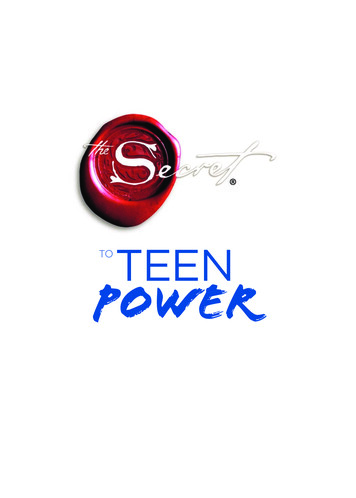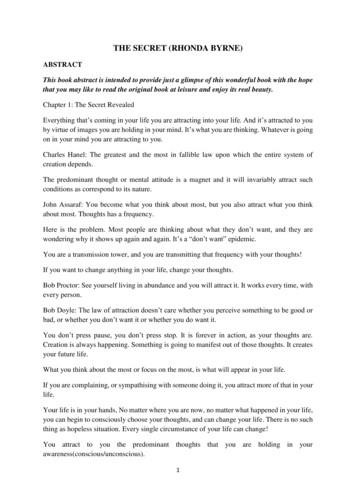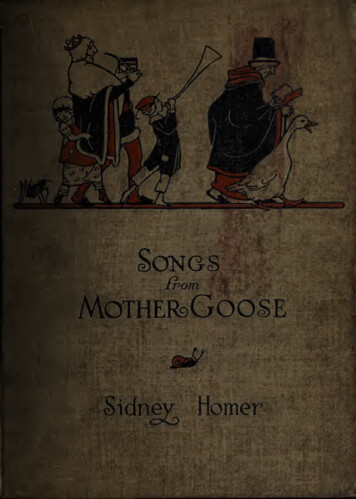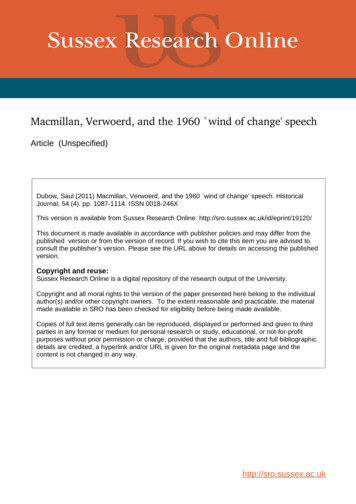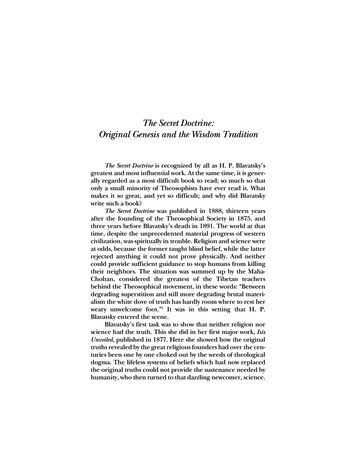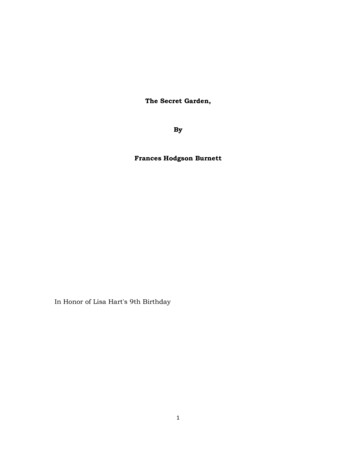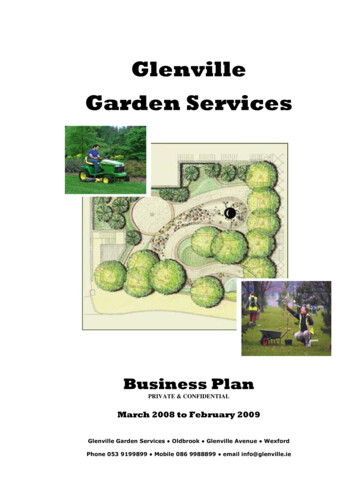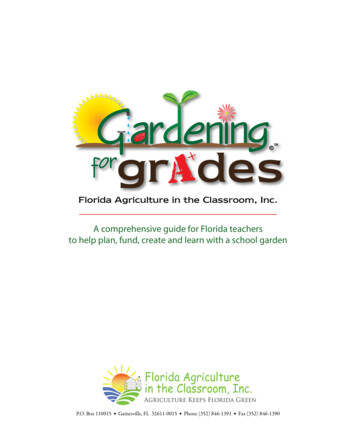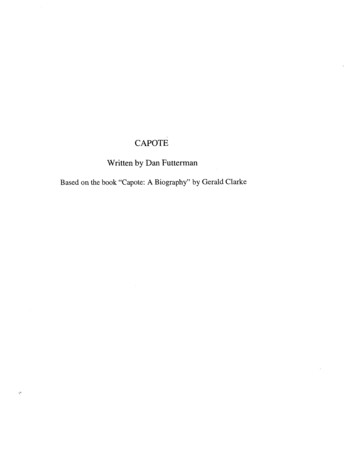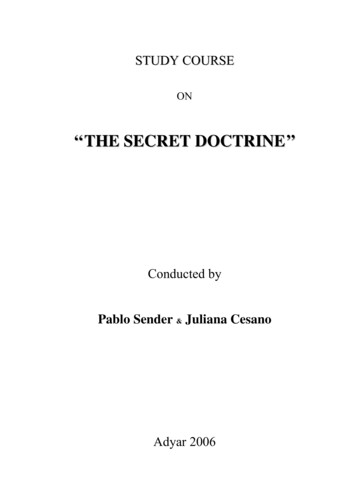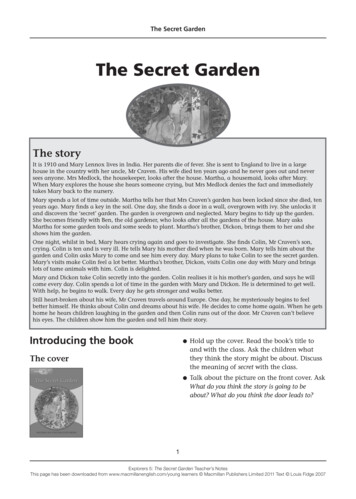
Transcription
The Secret GardenThe Secret GardenThe storyIt is 1910 and Mary Lennox lives in India. Her parents die of fever. She is sent to England to live in a largehouse in the country with her uncle, Mr Craven. His wife died ten years ago and he never goes out and neversees anyone. Mrs Medlock, the housekeeper, looks after the house. Martha, a housemaid, looks after Mary.When Mary explores the house she hears someone crying, but Mrs Medlock denies the fact and immediatelytakes Mary back to the nursery.Mary spends a lot of time outside. Martha tells her that Mrs Craven’s garden has been locked since she died, tenyears ago. Mary finds a key in the soil. One day, she finds a door in a wall, overgrown with ivy. She unlocks itand discovers the ‘secret’ garden. The garden is overgrown and neglected. Mary begins to tidy up the garden.She becomes friendly with Ben, the old gardener, who looks after all the gardens of the house. Mary asksMartha for some garden tools and some seeds to plant. Martha’s brother, Dickon, brings them to her and sheshows him the garden.One night, whilst in bed, Mary hears crying again and goes to investigate. She finds Colin, Mr Craven’s son,crying. Colin is ten and is very ill. He tells Mary his mother died when he was born. Mary tells him about thegarden and Colin asks Mary to come and see him every day. Mary plans to take Colin to see the secret garden.Mary’s visits make Colin feel a lot better. Martha’s brother, Dickon, visits Colin one day with Mary and bringslots of tame animals with him. Colin is delighted.Mary and Dickon take Colin secretly into the garden. Colin realises it is his mother’s garden, and says he willcome every day. Colin spends a lot of time in the garden with Mary and Dickon. He is determined to get well.With help, he begins to walk. Every day he gets stronger and walks better.Still heart-broken about his wife, Mr Craven travels around Europe. One day, he mysteriously begins to feelbetter himself. He thinks about Colin and dreams about his wife. He decides to come home again. When he getshome he hears children laughing in the garden and then Colin runs out of the door. Mr Craven can’t believehis eyes. The children show him the garden and tell him their story.Introducing the booklHold up the cover. Read the book’s title toand with the class. Ask the children whatthey think the story might be about. Discussthe meaning of secret with the class.lTalk about the picture on the front cover. AskWhat do you think the story is going to beabout? What do you think the door leads to?The cover1Explorers 5: The Secret Garden Teacher’s NotesThis page has been downloaded from www.macmillanenglish.com/young learners Macmillan Publishers Limited 2011 Text Louis Fidge 2007
The Secret GardenThe title pagelNow look together at the title page.lPoint out that it is a classic story that hasbeen re-told and simplified. (A classic story isone which is very good and has been popularfor a long time.)llAsk Who wrote the original story? (There issome information about the author on page80.) Ask Who adapted the story? (She madethe story simpler and easier to read.)lAsk the children to turn to the contents page.Explain that the Contents list tells us what isin the book.lAsk How many chapters are there? Read thechapter titles to and with the class. Brieflyexplain any unfamiliar words (most will becovered in the chapter notes). Ask thechildren what page each chapter starts on.lExplain that Mary is a girl and Martha is herhousemaid. Ben is an old gardener. Dickon isMartha’s brother. Mary is staying at MrCraven’s house and Colin is his son.lPoint out that at the end of the book there isa poem (‘The gardener’s morning’ on page74) and some information about how togrow a bean (beginning on page 76).lAsk questions about each chapter title tostimulate the children’s interest, for example:Note the ivy all around the outside of thepage. Ask the children what they think eachgarden tool (the spade, the fork and the hoe)are used for.Talk about the picture. Ask Where is the birdsitting? (on the handle of a spade) Ask Whatis a spade for? Describe the bird. (Note its redbreast. This bird is called a robin, orsometimes called a robin redbreast.) The birdis common in England. What is behind thespade? (a wall) The wall is covered with ivy,a dark green plant that grows and spreadsup walls.Chapter 1: Where do they think Mary hascome from?Chapter 2: Who are Martha and Ben?Chapter 3: Who does Mary think made thecry? Why?In which chapter is the word ‘secret’ used?In which chapter are there some animals?The contents pagelTell the children to do the related activity onpage 1 of their Workbook.You can play the story on the audiocassette/CD at any time you choose.2Explorers 5: The Secret Garden Teacher’s NotesThis page has been downloaded from www.macmillanenglish.com/young learners Macmillan Publishers Limited 2011 Text Louis Fidge 2007
The Secret GardenChapter 1Mary comes to EnglandActive vocabularyalonemany words begin with the prefix‘a‘, for example awake, asleep,aboardPages 3 to 9carriagenote the slightly unusual ‘iage’endingcorridorthe ‘or’ ending is very commonfrightenedthe ‘gh’ is silentillnessnote the ‘ll’ and ‘ss’lockedthe ‘ed’ is pronounced ‘t’nursemaidthis is a compound word: nurse maid nursemaidnurseryother ‘ery’ words are: pottery,bakery, jewellery, machineryservantthere’s an ant in this word!staredthe ‘are’ sounds like ‘air’stonechange the ‘st’ to ‘al’, ‘b’ and ‘ph’to make other ‘one’ words.the ‘g’ is a soft ‘g’ and ispronounced like ‘j’Passive raitstationrustlingwailingstamped her footBefore readinglPre-teach the active vocabulary (see theTeacher’s Notes Introduction page 13 and theGlossary). Use the notes in the table todiscuss any interesting features of the words.lAsk the children to do the activities onpage 2 of their Workbook to practise the newvocabulary.lRead the title of Chapter 1.3Explorers 5: The Secret Garden Teacher’s NotesThis page has been downloaded from www.macmillanenglish.com/young learners Macmillan Publishers Limited 2011 Text Louis Fidge 2007
The Secret GardenllllTell the children to look at the picture onpage 3. Ask Which of the two characters isMary? How is she dressed? How does she look?Who is the lady? How is she dressed? How doesshe look? Why do they both look so serious?Where are they sitting? How can you tell thecharacters lived in the past? Where do you thinkthey are going? Describe the countryside thatcan be seen out of the window.l– Read the chapter again and encourage theclass to read it with you.– Read the chapter again, a paragraph at atime, and ask the class (or individuals) toread each paragraph aloud after you.– Do not read again to the class. Ask groupsor individuals to read the chapter aloud, aparagraph at a time.Tell the children to look at the picture onpages 6 and 7. Ask What form of transport canyou see? Describe the horse and carriage. Dowe still see horse and carriages on the roadtoday? Who is in the carriage? Where is thevehicle going? Describe the house. Who lives inthe house? Is it a rich or poor person? Talkabout the grounds surrounding the house.Tell the children to look at the picture onpage 8. Ask Are Mary and Mrs Medlock insideor outside the house? How can you tell it is a bighouse? Describe what you can see. How do thegirl and the lady look?llRead (or play) the chapter again, aparagraph at a time. Explain the meaningand pronunciation of the words listed aspassive vocabulary, and any otherunfamiliar words.lDiscuss how the pictures can help the readerguess the meaning of the text.Stage 1 comprehension (literal)Ask these questions orally, or set them asa written activity. You can also ask thechildren to do the activity on page 3 of theirWorkbook.Optional suggestion: you may wish to givethe children an appropriate amount of time,for example five minutes, to look quicklythrough the chapter to find (and perhapsunderline) the active vocabulary they havebeen introduced to.1. What did Mrs Medlock say about the moor?2. What strange things happened to Mary onehot morning when she woke up?3. How old was Mary?4. What terrible news did the man tell Mary?During readinglChoose whichever of the following options ismost appropriate for your class:5. What did the children do to Mary whenshe went to stay with some friends of herfather’s?Point out that the sequence of the events inthe chapter is quite unusual. It begins withMary on a train in England and then herthoughts flash back to her living in Indiaand her parents dying of fever. The last partof the chapter explains how Mary came toEngland to live in a big house with her richuncle, Mr Craven.6. Where did the children say Mary was goingto live?7. How did Mary get to England?8. Who met her?9. Describe Mrs Medlock.Read the chapter expressively to the class (orplay the audio cassette/CD). Do not stop toexplain anything or to ask questions. Ensurethe children are following in their books.10. What did Mrs Medlock say about a) Mary’snew home? b) Mr Craven?11. Was the house far from the station?4Explorers 5: The Secret Garden Teacher’s NotesThis page has been downloaded from www.macmillanenglish.com/young learners Macmillan Publishers Limited 2011 Text Louis Fidge 2007
The Secret Garden12. What was the house like?1. Why do you think Mary asked ‘Is that thesea?’?13. How did Mary feel when she stood in the hallof the house?2. When all the strange things happened onehot morning a) how do you think Mary felt?b) what did Mary think?14. What were on the walls?15. Who was Mr Pitcher?3. Why was the man surprised when he openedthe door and saw Mary?16. What did Mrs Medlock tell Mary not to do?lllllRemind the children of the unusual sequenceof events in the chapter. Ensure childrenunderstand that Mary is thinking aboutwhat has happened to her as she is travellingon the train. This is how the reader discoversabout her parents and why she came toEngland. Discuss how sometimes we think ofthings that have happened to us in the past.4. How do you think Mary felt when she heardthe news about what had happened?5. Why do you think the boys called Marynames and laughed at her?6. What sort of things do you think Marythought about while she was on the ship,coming to England?7. Why did Mary think Mr Craven’s house wasa ‘sad house’?Ask the children to find examples ofquestions and exclamations in the chapter.Draw attention to their punctuation. Readeach one aloud and draw attention to howyour tone of voice changes.8. How can you tell that it was a long journeyfrom the station to the house?9. Why do you think Mary felt ‘small and alone’when she stood in the hall of the house?Ask the children to find and read aloudexamples of words containing ‘ea’; ‘oo’; ‘ar’and ‘or’.10. What was scary about the portraits on thewall?11. How do you think Mary felt when she finallyreached the nursery?There are several words containing doubleconsonants in them. Ask the children to findand read these words.12. Why do you think Mr Craven did not wantMary to go in any of the other rooms in thehouse?Finally, ask individuals to re-read shortsections of the text aloud. Encourage them toread expressively and with appropriateintonation. (You might like to ask thechildren to play the role of particularcharacters and read their parts.)Stage 2 comprehension (extra)Plot Encourage the children to understandthe chronological sequence of events in thischapter by listing in order the facts they havelearned. Mary lived in India with the parents.Her parents and everyone else in her houseexcept Mary died of a mysterious illness. Marywent stay at the house of one of her father’sfriends. She was told she was to come to Englandto live with her uncle, Mr Craven. She travelled toEngland on a ship.After readingStage 2 comprehension (extension)Ask these questions orally, or set them as awritten activity for the more able. Answerswill vary. Encourage the children to givereasons for their suggestions, and accept anyanswer they can justify.5Explorers 5: The Secret Garden Teacher’s NotesThis page has been downloaded from www.macmillanenglish.com/young learners Macmillan Publishers Limited 2011 Text Louis Fidge 2007
The Secret GardenlDiscuss what the children can discover aboutMr Craven in this chapter.lHave any of the class ever moved house?Discuss what it was like moving into astrange house and not knowing any peopleor the area. How did it feel? What did thechildren find difficult?lAsk the children to tell you the strangestthing that has ever happened to them. Askthem to recount their experiences.lWrite some of the words from the story onthe board and ‘forget’ to put in the vowels.Leave spaces for them. Ask the children tosupply the missing vowels.lPlay a rhyming game. Write these wordsfrom the chapter on the board: wife, small,sound, moor, night, cry, snake, kind, dead,house, dark, gate, coat, wall. Brainstorm as aclass, and write down on the board, as manywords that rhyme with each word as possible.lElicit from the class anything they knowabout England.lWrite these compound words on the board:staircase, driveway, everything, nursemaid,outside, housekeeper. Then read them and askthe children which two words make up eachword.lWrite the words nurse, girl and servant on theboard and read them aloud. What do theclass notice about the underlined letters ineach word? (They make the same sound.)Write these words on the board: person, bird,purse, shirt, Saturday, desert, verse, burn, first,term, thirsty, curve, lantern, third, purple. Askthe children to read them, explain theirmeanings and divide them into three sets.lIf appropriate, try some Extension Activities(see the Teacher’s Notes Introduction page19).lAsk What do you think will happen next in thestory?6Explorers 5: The Secret Garden Teacher’s NotesThis page has been downloaded from www.macmillanenglish.com/young learners Macmillan Publishers Limited 2011 Text Louis Fidge 2007
The Secret GardenChapter 2Martha and BenActive vocabularyPages 10 to 16garden‘ar’ is a very common letter patterngentlethe ‘g’ is a soft ‘g’ and ispronounced like ‘j’kitchenthere’s a ‘t’ in front of ‘ch’learnthe ‘ear’ is pronounced ‘er’lonelythere’s a number ‘hiding’ in thisword! (one)robinthis is a compound word: rob in robinsecretthe stress is on the first syllable ofthis two-syllable wordsmilenever smile at a crocodile on theRiver Nile!surprisedthe second ‘s’ is pronounced like a‘z’whistledthink of other ‘wh’ wordsPassive vocabularyivymeddleporridgeshillingsparsnipsBefore readinglPre-teach the active vocabulary (see theTeacher’s Notes Introduction page 13 and theGlossary). Use the notes in the table todiscuss any interesting features of the words.lAsk the children to do the activities onpage 4 of their Workbook to practise thenew vocabulary.lAsk the class to recall what happened in theprevious chapter.lRead the title of Chapter 2. Point out thatMartha and Ben are names of people.7Explorers 5: The Secret Garden Teacher’s NotesThis page has been downloaded from www.macmillanenglish.com/young learners Macmillan Publishers Limited 2011 Text Louis Fidge 2007
The Secret GardenllllTell the children to look at the picture onpage 11. Ask Who is the woman is who ishelping Mary dress? Draw attention to the wayshe is dressed. (She is Martha, a servant. Sheis the nursemaid who looks after Mary.) AskDescribe how she and Mary are dressed. How doMary and Martha look? What do you think theyare talking about? Where are they? How can youtell the weather is cold? What other things canyou see in the nursery?Stage 1 comprehension (literal)Tell the children to look at the picture onpage 14. Ask Is Mary inside or outside thehouse? Where is she? How is she dressed? Who isshe talking to? Is he young or old? How can youtell? What do you think they are talking about?How is Ben dressed? What is he leaning on?What can you see growing in the garden? Whatsurrounds the garden? Point out the tall wallswhich are covered with ivy. Ask Do yourecognise the bird from the cover of the book?4. What did Mary have for breakfast?Ask these questions orally, or set them asa written activity. You can also ask thechildren to do the activity on page 5 of theirWorkbook.1. What had Martha been doing when Maryspoke to her?2. What did Martha help Mary do?3. What did Martha tell Mary about her family?5. What did Martha tell Mary to put on?6. How long had the little garden been locked?7. Where was the key to the little garden?8. Who did Mary see in the kitchen garden?9. Describe the bird that Mary saw.10. What happened when the man whistled?11. What sort of bird was it?12. Why did the man say the bird was lonely?In each picture showing the garden, tell thechildren to look for signs which tell you whatseason of the year it is. (As the storyprogresses and the time passes, remember todraw the children’s attention to the smallchanges that can be seen in the pictures ofthe garden throughout the book as thingsbegin to grow and blossom.)13. What was the man’s name?14. Who did he say was his only friend?15. Who did Ben say Mary sounded like?16. Where did the robin fly to?17. What sort of trees did Ben say were in thesecret garden?18. What did Ben say about the door to thesecret garden?Optional suggestion: you may wish to givethe children an appropriate amount of time,for example five minutes, to look quicklythrough the chapter to find (and perhapsunderline) the active vocabulary they havebeen introduced to.lAsk the children to find examples of peoplespeaking in the text. Draw their attention tothe speech marks and discuss how they areused. Ask Which words go inside the speechmarks?lFind and read examples of words with twosyllables in them, for example window, purple,morning. As you read them out tap out orclap the syllables to help children hear them.During readinglRead the chapter to and with the class.Follow the same procedure as you did forChapter 1 (see page 4) to help the childrenread and understand the text. Use the audiocassette/CD, if you wish.8Explorers 5: The Secret Garden Teacher’s NotesThis page has been downloaded from www.macmillanenglish.com/young learners Macmillan Publishers Limited 2011 Text Louis Fidge 2007
The Secret GardenllAsk the children to find and read any wordscontaining a double consonant, for exampledress, buttons. Ask Is the double consonant atthe end of each word or in the middle?8. How can you tell the old man and the robinare friends?Ask the children to find and read aloudexamples of verbs which end with ‘ed’ (thesuffix which indicates that the verb has a‘regular’ past tense) for example asked,pointed.10. Why do you think Mary was lonely?lAsk the children to find as many adjectivesas possible in the chapter and say who orwhat they describe, for example purple sea.lFinally, ask individuals to re-read shortsections of the text aloud. Encourage them toread expressively and with appropriateintonation. (You might like to ask thechildren to play the role of particularcharacters and read their parts.)9. Why do you think the robin made Mary feelhappy?11. What do you think Ben meant about Dickonwhen he said, ‘even the trees and the flowersknow him!’?12. Do you think Ben was telling the truth whenhe said that there was a door to the lockedgarden ten years ago, but there wasn’t onenow?Stage 2 comprehension (extra)Author’s style The author is clever becauseshe makes the reader want to find out moreabout the mysterious secret garden. Usingthe word ‘secret’ is very clever, too, because itimplies not many people know about it. Askthe children to write down everything theyhave found out about the ‘secret’ garden sofar.After readingStage 2 comprehension (extension)Ask these questions orally, or set them as awritten activity for the more able. Answerswill vary. Encourage the children to givereasons for their suggestions, and accept anyanswer they can justify.lBen worked in the garden. He was agardener. Notice how the ‘er’ suffix is addedto give the name of a job. Add ‘er’ to thesewords: build, teach, sing, paint, farm, clean,report, climb, box. Ask the children what eachword means and ask them to make upsentences containing them.lWhen we change a singular noun ending inconsonant y into the plural, we change the‘y’ to ‘i’ and add ‘es’, for example pony –ponies. Ask the children to change thesenouns into the plural: spy, baby, lady, lorry,party, city, family.lIn the garden Mary saw parsnips andcabbages growing. Brainstorm and list asmany different vegetables as possible.lIn the garden Mary saw a robin. Brainstormand list as many different birds as possible.1. Why do you think Martha’s cheeks were red?2. Why do you think Martha was surprisedwhen Mary asked who would dress her?3. How can you tell Martha’s family are poor?4. What did Martha mean when she said toMary, ‘The wind will put some colour in yourwhite cheeks.’?5. Why do you think Mr Craven locked the littlegarden when his wife died?6. Why do you think there wasn’t much to seein the kitchen garden in the winter?7. Why do you think Mary calls the lockedgarden ‘the secret garden’?9Explorers 5: The Secret Garden Teacher’s NotesThis page has been downloaded from www.macmillanenglish.com/young learners Macmillan Publishers Limited 2011 Text Louis Fidge 2007
The Secret GardenlThe robin cheered Mary up when she wasfeeling sad. Ask What sort of things cheeryou up?lMary wanted a pet. Ask Do any of you haveany pets at home? Ask them to tell the rest ofthe class about them.lMary and Ben were both lonely. Ask Whatsort of things make a person lonely? What canwe do if we know someone is lonely?lVarious relatives are mentioned in thechapter, for example father, mother, wife,sisters, uncle. List as many other relatives aspossible and say whether each is masculineor feminine.lAsk Are you any good at keeping secrets?lIf appropriate, try some Extension Activities(see the Teacher’s Notes Introduction page19).lAsk What do you think will happen next in thestory?10Explorers 5: The Secret Garden Teacher’s NotesThis page has been downloaded from www.macmillanenglish.com/young learners Macmillan Publishers Limited 2011 Text Louis Fidge 2007
The Secret GardenChapter 3A cry in the nightActive vocabularyPages 17 to 23branchother words containing ‘nch’ are:bunch, lunch, punch, pinch, launchbreakfastthe ‘ea’ is pronounced like a short‘e’differentthe first ‘e’ is often incorrectly leftout by some children when spellingthis wordinterestedthere is an ‘er’ in this word and indifferentlibrarytap out the syllables in this threesyllable word as you say itnonsensethe prefix ‘non’ means ‘no’ in thiswordremindedthe prefix ‘re’ is fairly commonseatchange the ‘s’ to ‘b’, ‘h’, ‘ch’, ‘m’,‘tr’, ‘wh’ to make some new wordssobbednote the ‘bb’wanderedthe ‘an’ is pronounced ‘on’weatherchange the ‘w’ to ‘f’ to get part ofa bird!Passive vocabularycubfeel sorry forivoryknitlacemarchingmazemistsilkvelvetBefore readinglPre-teach the active vocabulary (see theTeacher’s Notes Introduction page 13 and theGlossary). Use the notes in the table todiscuss any interesting features of the words.lAsk the children to do the activities onpage 6 of their Workbook to practise thenew vocabulary.lAsk the class to recall what happened in theprevious chapter.lRead the title of Chapter 3. Ask What do youthink the chapter is going to be about?11Explorers 5: The Secret Garden Teacher’s NotesThis page has been downloaded from www.macmillanenglish.com/young learners Macmillan Publishers Limited 2011 Text Louis Fidge 2007
The Secret GardenllllTell the children to look at the picture onpage 19. Ask Why do you think Mary has comeout of the nursery? Where do they think she isgoing?5. What did Martha say when Mary heardsomeone crying?Tell the children to look at the picture onpage 20. Ask What is Mary looking at? Where isthe mouse? Is Mary frightened of the mouse? Isshe in the nursery? Whose room do you think sheis in? Ask them to describe everything theycan see in the room.7. How many books did Martha say were in MrCraven’s library?Tell the children to look at the picture onpage 22. Mary is back in the nursery. AskWhy do you think she is crying? How do youthink she got back to the nursery?10. What did Mary find in the lady’s sittingroom?Optional suggestion: you may wish to givethe children an appropriate amount of time,for example five minutes, to look quicklythrough the chapter to find (and perhapsunderline) the active vocabulary they havebeen introduced to.12. What noise did she hear?6. What did Dickon call a) the fox cub? b) theyoung crow?8. When did Mary go out of the nursery andexplore the house?9. How long did she wander through the house?11. Why did Mary get lost on her way back tothe nursery?13. Who came marching towards her?14. How did Mrs Medlock look?15. What did Mrs Medlock say when Mary toldher she had heard someone crying?16. What did Mrs Medlock do when they reachedthe nursery?During readingl17. What did Mary do after Mrs Medlockslammed the door?Read the chapter to and with the class.Follow the same procedure as you did forChapter 1 (see page 4) to help the childrenread and understand the text. Use the audiocassette/CD, if you wish.lAsk the children to find some commas in thetext. Check that the children know that theytell the reader to pause briefly, to help youmake more sense of the sentence. Read a fewsentences again to demonstrate.lThere are several examples of compoundsentences in the text which are joined usingthe conjunction ‘and’, for example Everymorning, she woke and (she) watched Marthalighting the fire. Find and read some of thesesentences and discuss how they work. Forexample, the two sentences Every morning, shewoke and (she) watched Martha lighting the fire.become one long sentence: Every morning, shewoke, and (she) watched Martha lighting thefire.Stage 1 comprehension (literal)Ask these questions orally, or set them asa written activity. You can also ask thechildren to do the activity on page 7 of theirWorkbook.1. What was the first thing Mary watchedMartha do every morning?2. What happened when Mrs Craven wassitting on a low branch of a tree in hergarden?3. When did Mr Craven lock her garden?4. When Mary heard about how Mrs Cravendied how did she feel?12Explorers 5: The Secret Garden Teacher’s NotesThis page has been downloaded from www.macmillanenglish.com/young learners Macmillan Publishers Limited 2011 Text Louis Fidge 2007
The Secret GardenllllFind some irregular past tenses in the text,for example woke, ate, went. Discuss howregular past tenses like watched are formedby adding ‘ed’, whereas irregular past tensesdo not follow this rule.7. Did Mary really go to look for the library orgo to explore the house?8. How can we tell it was a big house on page21?9. How do you think Mary felt when she tried adoor – and it opened?Look for ‘time marker’ words or phrases inthe text and discuss how they indicate thepassing of time in the story, for exampleevery morning, then, One day.10. How do you think Mary felt when she heardsomeone crying again?11. Why do you think Mrs Medlock had so manykeys?Ask the children to find and read any wordsof more than six letters in the chapter. Decidehow many syllables each word contains.12. Why do you think Mrs Medlock looked cross?13. Why do you think Mrs Medlock said‘Nonsense!’ when Mary told her she hadheard someone crying?Finally, ask individuals to re-read shortsections of the text aloud. Encourage them toread expressively and with appropriateintonation. (You might like to ask thechildren to play the role of particularcharacters and read their parts.)14. How can you tell Mrs Medlock was still crosswith Mary when they reached the nursery?15. What made Mary ‘white with anger’?After readingStage 2 comprehension (extra)Stage 2 comprehension (extension)Characterisation We can learn a lot moreabout Mary in this chapter. Ask the childrento write down five more facts they havelearned about her by reading Chapter 3.Ask these questions orally, or set them as awritten activity for the more able. Answerswill vary. Encourage the children to givereasons for their suggestions, and accept anyanswer they can justify.lMary went looking around the house to seewhat she could find. Write the word branchon the board. Ask the children which smallword is ‘hidden’ inside it? (ran) Write thesewords on the board and look for smallerwords inside each word: breakfast, watched,pink, stared, listened, blowing, started, cottage,weather, thousands, interested, covered.lWrite the words strange and cottage on theboard and read them aloud. Point out thatthe ‘g’ sounds like ‘j’. We call this a soft ‘g’.Ask the class to complete these words with asoft ‘g’ and read the words they make: entle,en ine, ima ine, ma ic, emer ency, chan e,iant, ym.1. Why do you think Mary ate a little morebreakfast every day?2. Why do you think Mary wanted to go intothe secret garden so much?3. Why do you think Mr Craven locked thegarden after his wife’s death?4. What do you think this tells you about Mary:‘For the first time in her life, she felt sorry forsomeone.’?5. Why do you think Martha said it was thewind, when Mary heard someone crying?6. What can you discover about Dickon’s love ofanimals on page 18?13Explorers 5: The Secret Garden Teacher’s NotesThis page has been downloaded from www.macmillanenglish.com/young learners Macmillan Publishers Limited 2011 Text Louis Fidge 2007
The Secret GardenlWrite the words hop and hopped, slam andslammed and sob and sobbed on the board.Ask the children to say what happens to thespelling of the past tense of the verb when‘ed’ is added. (The final consonant isdoubled.) Tell the children that this happenswith all single syllable regular verbs whichend with a short vowel and consonant. Writethese verbs on the board and ask the childrento add the ‘ed’ suffix and write their pasttenses: hum, hug, zip, tap, beg, tip, stop, shop,jog, rob.lMary said she couldn’t k
Explorers 5: The Secret Garden Teacher’s Notes . Introducing the book The cover l Hold up the cover. Read the book’s title to and with the class. Ask the children what they think the story might be about. Discu
